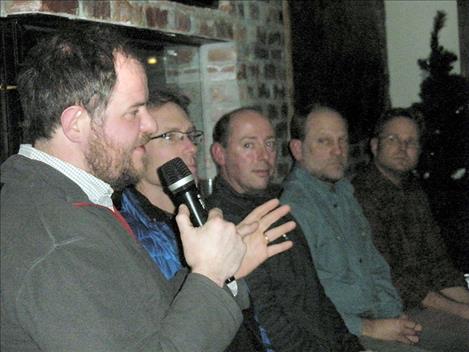Mussels the topic at 'Science on Tap'
Hey savvy news reader! Thanks for choosing local.
You are now reading
1 of 3 free articles.
BIGFORK – Education and funding are the two biggest things that are needed to prevent a mussel infestation in local lakes. That was the consensus from a panel of experts who spoke at “Science on Tap” at Flathead Lake Brewing Co. on Jan. 3.
Funding might come directly from the Legislature, or they could approve something like what Idaho’s Legislature did.
Tom Bansak, assistant director of the Flathead Lake Biological Station at Yellow Bay, said Idaho spends $10 million a year to make sure its water bodies are free of aquatic invasive species such as quagga or zebra mussels. (Montana spends about $1 million a year, he said.) Idaho does it largely through a “sticker program” whereby the owner of a boat must pass an inspection before launching.
Idaho approved such a law because the irrigated agriculture lobby got it through, Bansak said.
This helps protect Montana from mussels from the southwest, but he noted that a lot of mussels are in states to the southeast of Montana.
“It’s an ecological major threat, and an economic major threat,” he said at the monthly meeting, sponsored by the FLBS and the Flathead Lakers.
Montana’s Legislature has been resistant to a sticker program. “They don’t want to put the burden on boaters and fishermen,” he said, adding that he and others have been talking about such a program in Montana for five years. “The western Montana representatives are aware of it (the mussel threat), but in eastern Montana the view of water is different,” he said.
The FLBS sampled 30 areas in Flathead Lake for mussels in early November. The first results should be available this month or next. The testing came after mussel larvae were detected at the Tiber and Canyon Ferry reservoirs in eastern Montana.
Shawn Devlin, assistant research professor at FLBS, said the organization is one-third of the way toward its funding goal of testing all of the samples that it took.
“We’re strapped for funding,” he said.
Georgia Smies, an aquatic biologist with the Confederated Salish and Kootenai Tribes, emphasized a “clean, drain and dry” theme for boat owners.
The No. 1 tool in protecting lakes from mussels is education, she said, citing information gleaned from those in the Lake Tahoe area, which straddles the California/Nevada border in the Sierra Nevada Mountain Range.
Lake Tahoe has no mussels, she said, adding that some 550,000 boats are launched there annually, but specifically only within the six warmer months of the year.
The Lake Tahoe area spends about $1.5 million a year on aquatic invasive species control, she said. About $750,000 of this comes from a local sticker program for boaters. Local irrigators have borne most of the rest of the costs, she said, adding that a small amount comes from the state Legislature.
Smies said CSKT is taking the mussel threat “very seriously” and plans to host public meetings in the future.
The panel answered numerous questions at the Science on Tap presentation, where $1 of each pint of beer purchased goes toward the two sponsoring organizations.
Gordon Luikart, a professor at FLBS, said that once mussels are detected in a body of water it’s usually too late to eradicate them, although he cited two examples from Colorado where it was done. However, those lakes have low calcium levels, and Flathead Lake’s is pretty high, he said. The mussels need a certain amount of calcium for their shell.
“There is hope with drawdown in some water bodies,” he said. “It’s like cancer, you’ve got to detect it early.”
Mussels can’t survive in water with a low pH level. “But water conditions in Flathead Lake are just fine for them,” he said.
“They spin a bissel thread and can grow on anything. Native mussels (to Montana) can’t do that. They burrow in sand.”
“To spin bissel thread, they need enough food,” Devlin said. “No one knows what kind of food they need.”
Citing a Minnesota model, Luikart said education is key. “It’s peer pressure and changing behaviors,” he said.
The panel doesn’t know which mussel species, quagga or zebra, are in Montana because only larvae have been found, Luikart said, noting that zebra mussels are the nastiest.
Bluegill and sunfish eat mussels, but it’s not enough, he added.
Glacier National Park had two representatives in the panel discussion. GNP’s fisheries program manager Chris Downs said the park is going to keep its lakes closed to boats “until we figure out the nature of the threat.”
















